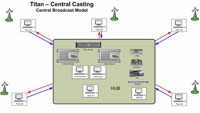Centralcasting revisited
A few years back, centralcasting was proposed as a potential cost-saving measure for station groups. The original idea of running all the remote stations from a group headquarters sounded great until the cost of fiber connections was factored in.
As networks and groups look to take further cost out of operations, it makes sense to revisit centralcasting. The concept is simple: pull back most operations to a central site with the remote, or spoke, stations solely responsible for the local news and weather. When the concept was first vaunted, it soon became apparent that the cost of high-bandwidth circuits made the business case marginal.
Much has changed in the last couple of years, with long-haul fiber costs falling, so now the economics begin to make sense. One factor that is increasing the availability of fiber and pushing down costs comes from government initiatives to expand broadband outside metropolitan areas. Around the world, governments are keen that rural voters do not become second-class digital citizens. As an example, in the United States, one part of the Recovery Act (2009) is to provide broadband access to rural communities through the RUS Broadband Initiatives Program (BIP) and the NTIA Broadband Technology Opportunities Program (BTOP).
As rural broadband networks roll out over the next few years, smaller communities will be connected to telco backbones with trunk fiber. The network operators will no doubt be looking for other customers for that fiber. As a spin-off, broadcast groups could use this new capacity to connect their remote stations to a central hub.
Spoke or hub?

There are many possible ways to design a centralcasting system. The original design delivers all content from the central site to the remote transmitters over high-bandwidth circuits. The local spoke station just intercepts the feed for local newscasts and weather.
All content is ingested, prepared and checked at the central site. This will deliver staff savings, but it adds the cost of the interconnecting circuits. An alternative design is to ingest and play out locally, but to control the playout from the central hub. The station can switch to local control during the morning and evening newscasts but can easily save a master control shift by running from the central station outside those periods. This saves on staff and fiber network costs, but still has duplicated tasks, in that each local station must ingest and prepare the same syndicated programming.
The professional video industry's #1 source for news, trends and product and tech information. Sign up below.
For most station groups, the sweet spot will fall somewhere between. Common programming can be ingested and checked at the central station, but the local station can manage all locally sourced content. Operations like graphics creation can also be centralized, aiding to a common look and feel across a group.
“In all cases, we assume that each of the spokes will need to take local control from time to time, with requirements from a full slate of local newscasts or simple breaking news and weather breakaways,” said Rick Stora, product manager for Sundance Digital at Avid.
“Many operations simply split control by day part.” Stora said. “Give the spokes control from 5 a.m. to 9 a.m. for newscasts and inserts. Regain control for the evening news blocks, prime-time through the late news. The rest of the time, the hub can take over control during lower-priority day parts. This way, a station can eliminate a full master control shift without risking the problems of a ‘lights out’ scenario.”
Add to this recent developments like WAN acceleration, which improves the efficiencies of large file transfers over the fiber networks, and centralcasting becomes a far more feasible business concept than once thought.
